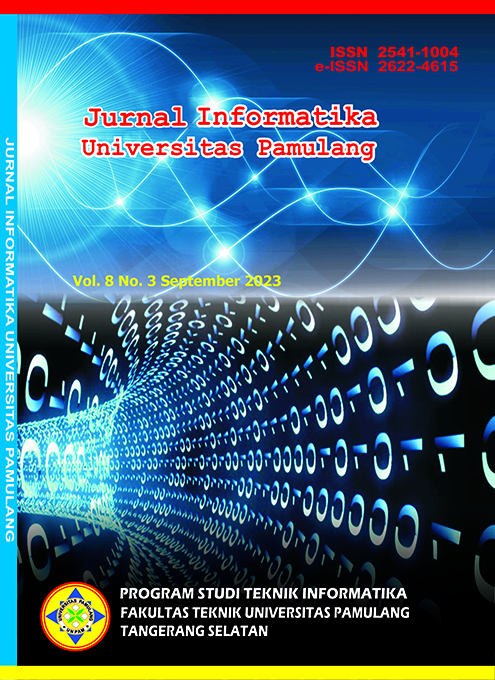Perancangan Sistem Evaluasi Tingkat Kompetensi Alumni dengan Algoritma Support Vector Machine (SVM) Linear Method Berbasis Framework Streamlit
DOI:
https://doi.org/10.32493/informatika.v8i3.33766Keywords:
tracer, competence, SVM, streamlit, system, evaluationAbstract
Extensive use of alumni data by evaluating alumni competency levels, such as in the world of education, human resources, or university rankings. Therefore, the use of powerful algorithms such as SVM and easy-to-use interfaces such as Streamlit can provide great benefits in various contexts. How to measure the performance of the SVM model in assessing alumni competency levels, and how to interpret the evaluation results correctly for users is the main focus of this research. One way of searching for alumni is to assess the competitiveness of graduates and collect relevant assessment information from universities. This research is a continuation of the analysis of alumni competency levels using the SVM algorithm method which was implemented using the Streamlit application to determine (alumni's) perceptions of skill proficiency and the level of skills demanded by the world of work. The data used results from the UNISKA Tracer 2021 questionnaire responses to questions of 30 competencies from 3,117 respondents. The results of the implementation created will display the results of the classification with the information Competent and Not Competent by entering the values of 30 variables in the Tracer Study results. If the competency is in alumni, we know that companies can also support personal development through training or certain training courses. One way to assess a student's skill level in machine learning is to use a dataset as training data so that benchmarking can be carried out using accurate classification methods.References
L. M., & Pangestu, M. A. (2023). Monitoring of Lake Water Quality Through Streamlit Web Application (Case Study: Lake Matano and Lake Towuti. South Sulawesi). Geoid, 18(2), 293–301.
Amal, I., Pamungkas, E., Kom, S., & Kom, M. (2023). Aplikasi Pendeteksi Berita Palsu Bahasa Indonesia Menggunakan Framework Flask Dan Streamlit Serta Algoritma Machine Learning.
Endang Etriyanti. (2021). Perbandingan Tingkat Akurasi Metode Knn Dan Decision Tree Dalam Memprediksi Lama Studi Mahasiswa. Jurnal Ilmiah Binary STMIK Bina Nusantara Jaya Lubuklinggau, 3(1), 6–14. https://doi.org/10.52303/jb.v3i1.40
Harianto, K., Pratiwi, H., Suhariyadi, Y., Widya, S., Dharma, C., Yamin, J. M., 25 Samarinda, N., & Timur, K. (2019). Sistem Monitoring Lulusan Perguruan Tinggi Dalam Memasuki Dunia Kerja Menggunakan Tracer Study. In Jurnal Sains Komputer & Informatika (J-SAKTI (Vol. 3).
Informasi, R. A.-J., Teknologi, S. dan, & 2021, undefined. (n.d.). Monitoring Kualitas Air Sungai Secara Realtime Berbasis Internet Of Things Dan Big Data. In isaintek.polinef.ac.id.
Kamila, V. Z., & Subastian, E. (2020). Analisis Dan Perancangan Sistem Evaluasi Pelatihan Tenaga Kependidikan. Sebatik, 24(2). https://doi.org/10.46984/sebatik.v24i2.1125
Nurdiansyah, Y. (2017). Informal : informatics journal. 2(2), 114–122.
Ochkov, V. F., Sutchenkov, A. A., & Tikhonov, A. I. (2021). Python Computational Web Apps for STEM Engineering Education. International Journal of Education and Information Technologies, 15, 130–136. https://doi.org/10.46300/9109.2021.15.13
Pulungan, A., Informatika, D. S.-I. J. N., & 2022, undefined. (n.d.). Kombinasi Metode Sampling pada Pengklasifikasian Data Tidak Seimbang Menggunakan Algoritma SVM. Jurnal.Uisu.Ac.Id.
Ridwan, A. (2020). Penerapan Algoritma Naïve Bayes Untuk Klasifikasi Penyakit Diabetes Mellitus. Jurnal SISKOM-KB (Sistem Komputer Dan Kecerdasan Buatan), 4(1), 15–21. https://doi.org/10.47970/siskom-kb.v4i1.169
Downloads
Published
Issue
Section
License
Copyright (c) 2023 Indu Indah Purnomo, Andie Andie

This work is licensed under a Creative Commons Attribution-NonCommercial 4.0 International License.
Authors who publish with this journal agree to the following terms:
- Authors retain copyright and grant the journal right of first publication with the work simultaneously licensed under a Creative Commons Attribution-NonCommercial 4.0 International (CC BY-NC 4.0) that allows others to share the work with an acknowledgement of the work's authorship and initial publication in this journal.
- Authors are able to enter into separate, additional contractual arrangements for the non-exclusive distribution of the journal's published version of the work (e.g., post it to an institutional repository or publish it in a book), with an acknowledgement of its initial publication in this journal.
- Authors are permitted and encouraged to post their work online (e.g., in institutional repositories or on their website) prior to and during the submission process, as it can lead to productive exchanges, as well as earlier and greater citation of published work (See The Effect of Open Access).
Jurnal Informatika Universitas Pamulang have CC-BY-NC or an equivalent license as the optimal license for the publication, distribution, use, and reuse of scholarly work.
In developing strategy and setting priorities, Jurnal Informatika Universitas Pamulang recognize that free access is better than priced access, libre access is better than free access, and libre under CC-BY-NC or the equivalent is better than libre under more restrictive open licenses. We should achieve what we can when we can. We should not delay achieving free in order to achieve libre, and we should not stop with free when we can achieve libre.
Jurnal Informatika Universitas Pamulang is licensed under a Creative Commons Attribution-NonCommercial 4.0 International (CC BY-NC 4.0)
YOU ARE FREE TO:
- Share : copy and redistribute the material in any medium or format
- Adapt : remix, transform, and build upon the material for any purpose, even commercially.
- The licensor cannot revoke these freedoms as long as you follow the license terms





